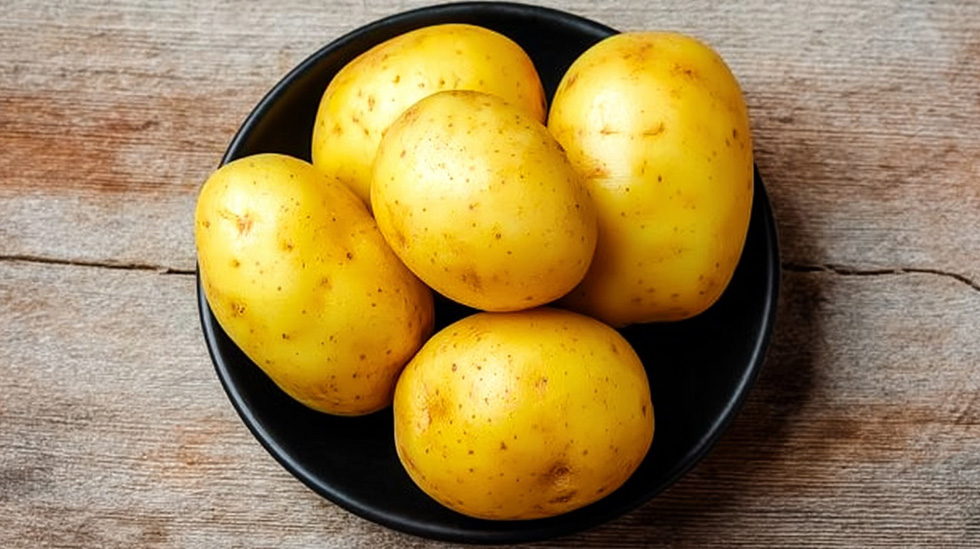On what tree do yellow potatoes grow?
Yellow potatoes – also known as golden potatoes or butter potatoes – are the tuber of the plant Solanum tuberosum, the underground food storage part of the plant. The potato originated in South America, in what is now Peru and Bolivia, where it has been cultivated for more than 7-8000 years. It arrived in Europe in the 16th century and has since become firmly established in the gastronomy of the continent, particularly in Central and Eastern Europe.

There are many types of potato, and although we often think of them all as potatoes, there can be huge differences in terms of their use in the kitchen:
- Yellow potatoes: medium firm, slightly buttery, rich in flavour. Ideal for baking, cooking and casseroles. Its yellowish flesh makes it more appetising to look at.
- Red potatoes: thin-skinned, firmer, harder to cook, they are perfect for salads and roasting.
- New potatoes: the first potatoes of the season, not yet fully ripe. The skin is very thin and can often be eaten without peeling. The taste is sweeter, fresh.
- Parsnips: Small, often baked whole in their skins, they are popular for grilled dishes. They are quick to prepare and showy.
Yellow potatoes are the most versatile of these: they are tasty, easy to handle and can be included in the daily menu in all seasons.
Importance level in the kitchen: 5/5
The yellow potato is a staple food in Hungary, and very popular throughout Europe. Once you run out, it’s hard to replace it: mashed, in casseroles, side dishes, cream soups – it’s everywhere. Its texture and taste make it a favourite in most Hungarian households. Simply unmissable.
What is edible and what is not?
The edible part of the yellow potato is the tuber itself, the storage organ that develops underground. It can be eaten peeled, boiled, baked or even peeled. However, it is important to:
- Do not eat potatoes with a greenish tinge or sprouting! They contain solanine, which can be toxic in higher quantities.
- Potato stalks, leaves and flowers are also poisonous and should never be put on your plate.
Why is it good for us?
Yellow potatoes are not only delicious, they are also rich in nutrients:
- Vitamin C: Strengthens the immune system (especially when cooked in its shell!)
- Vitamin B6: Helps the nervous system
- Potassium: Supports heart and muscle function
- Carotenoids: antioxidants, may help protect cells
In folk medicine, it has also been used for stomach ailments, to relieve inflammation and as a diuretic.
Where does it come from, when does it come?
Yellow potatoes are grown almost all over Europe. The largest producing countries are:
- Germany – one of the biggest potato powers
- France – high quality gastro potatoes
- The Netherlands – where many exports come from
It is also grown in significant quantities in Hungary, mainly in the Nyírség and the Southern Great Plain. The main season of the domestic yellow potato lasts from late July to mid-October. In winter and spring, you can typically find imported potatoes in the shops – if Hungarian origin is important, always check the label!
How to choose the best specimens
Recognising a good quality yellow potato is not a fool’s errand, you just need to pay attention to a few things:
- Shell: smooth, undamaged, not wrinkled or cracked
- Colour: Nice yellow inner flesh, light to yellowish skin
- Texture: should not be soft or spongy to the touch
- Sprouts: avoid those that have already started to sprout
How to store it?
Potatoes’ best friend is darkness and cool air! Store:
- In a dark, well-ventilated place
- At cool temperatures (ideally 6-10 °C)
- Not in the fridge! There the starch turns into sugar, which makes it sweet and soft
Don’t store it with onions, as this will speed up spoilage.
Tastes of the world – potato style
Yellow potatoes are served in many different ways around the world:
- France: gratin fried in butter, mashed potatoes with cream
- Spain: tortilla de patatas (omelette-like potato dish)
- Italy: gnocchi – potato pasta with sage butter
- India: spicy “aloo” dishes, in curry or fried form
And what else in Hungary? Paprika potatoes or casserole potatoes! 😋
Classic recipe: baked potatoes with Tepsis
This dish brings out the flavour of the yellow potato to the maximum and is almost indestructible:
Ingredients:
- 1 kg yellow potatoes
- 2-3 tablespoons olive oil
- 1 teaspoon salt
- Freshly ground pepper
- 1 teaspoon rosemary or thyme
Preparation: wash the potatoes, peel them or leave them in their skins, then cut them into chunks. Toss with the oil and spices and bake at 200°C for 35-40 minutes until crispy on the outside and creamy soft on the inside.
Kitchen tips and tricks
Yellow potatoes can be used in almost any type of cooking. Here are some ideas:
- For casseroles: keeps its shape well, does not cook easily
- Purees: creamy but not floury – a dream with a little butter
- As a soup garnish: diced or diced, it absorbs flavours well
Spices that go with it: garlic, rosemary, thyme, parsley, nutmeg, sweet paprika
What to avoid: Excessive vinegar or acidic dressings because they will fall apart and lose flavor.
Summary
Yellow potatoes are not only beautiful, they are tasty, nutrient-rich and versatile. Whether it’s a quick weeknight dinner or a festive feast, it’s sure to have a place on your plate. The next time you’re at the grocery store, don’t hesitate – add them to your basket, because yellow potatoes are always a good choice!
